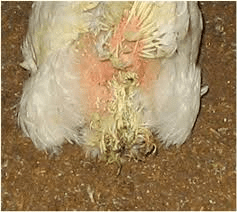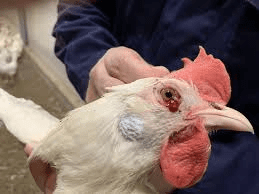As symptoms of poultry diseases are noticed on the external part of the birds, they could also be noticed in the internal organs. A serious poultry farmer can sometime take time off to examine a victim bird of a certain disease which seems strange or familiar.
Symptoms of diseases like Chronic Respiratory, Wet Pox etc can be noticed internally when properly examined.
The round heart disease for instant which make the heart of infected birds to swell and increase its size can be noticed when properly examined but this practice does not mean that you should ignore the veterinarians and other experts because they are in the best position to advice poultry farmers what to do against any disease, they know much better the drugs to apply to a certain disease and they are the birds doctor.
All what you need to do is to acquaint yourself with common clinic instruments such as:
- Operation table
- Operation light
- Straight scissors
- Curved scissors and
- Drugs
You should always ensure strict measures of sanitation whenever you want to observe the internal organs of a bird.
Diagnostic organs: for proper examination of a bird, you should start cutting from both sides of the mouth down to the anus and ensure that no part of the internal organs is misplaced. Wash it off, examine each and everyone of the organs carefully.
Mouth: the mouth of the bird should be well examined whether the signs of wet-pox disease could be traced.
Trachea: Trachea should be well examined properly by cutting it length wise and open to see if there are mucus or injuries caused by disease.
Crop: you should carefully cut the crop into 2 equal parts. If it is a bird suffering from Fungus infection, you should note that the lining inside the crop would be thickened and rough, as a result of injuries inflicted on it by disease.
Read Also: Poultry External Parasites and Control Measures
Liver: the liver should be observed properly after washing it off. In the liver of a bird suffering from mycoplasma infection, a false slimy yellowish membrane would be noticed and in case of big liver disease, the liver would appear bigger than usual.
Heart: you must ensure that you do not carelessly remove the liver in a bird to examine the heart. In case of round heart disease, you would notice that the size of the heart has been increased out of proportion which makes the vein to be filled with blood and the heart would not be as thick as usual.
Gizzard: one of the parts that are commonly affected by disease in the internal organs of bird is the gizzard. Gizzard worms can be found under the lining of the organs and it is not more than one inch in length.
You can prevent the occurrence of gizzard worms by avoiding insects being swallowed by birds.
Small intestine: the small intestine should be cut length wise to enable you see every part and the lining can be well examined.
Read Also: Worm infection among Poultry Birds: Types, Causes and Treatment
Meanwhile, a parasite is an organism that lives in or on another organism (referred to as the host) and gains an advantage at the expense of that organism.
The two types of internal parasites that affect poultry are worms and protozoa. Usually, low levels of infestation do not cause a problem and can be left untreated.
Clinical signs of a parasite infestation include unthriftiness, poor growth and feed conversion, decreased egg production, and, in severe cases, death. Also, parasites can make a flock more susceptible to diseases or worsen a current disease condition.
Types of Worms as Poultry Diseases

(1) Roundworms
Roundworms (nematodes) are common in poultry, waterfowl, and wild birds. Species of roundworms that affect poultry include species of large roundworms (Ascaris sp., also known as ascarids), species of small roundworms (Capillaria sp., also known as capillary worms or threadworms), and cecal worms (Heterakis gallinarum).
Roundworms can cause significant damage to the organ(s) they infest. Most roundworms affect the digestive tract; others affect the trachea (windpipe) or eyes.
Large roundworms are the most damaging of the worms common to backyard flocks. A severe infestation can cause a reduction in nutrient absorption, intestinal blockage, and death.
Easily seen with the naked eye, large roundworms are about the thickness of a pencil lead and grow to 4-1/2 inches long. Occasionally, they migrate up a hen’s reproductive tract and become included in a developing egg.
The life cycle of a roundworm is direct; that is, worm eggs are passed in the droppings of infected birds and then directly to birds that consume contaminated feed, water, or feces.
Also, worm eggs may be picked up by snails, slugs, earthworms, grasshoppers, beetles, cockroaches, earwigs, and other insects. Known as intermediate hosts, these insects carry the eggs and when eaten by a bird pass the eggs to the bird.
Read Also: Cold Weather Poultry Diseases and How to Manage them
Identifying and minimizing the number of intermediate hosts that poultry have contact with helps prevent the birds from being infected with worms.
Medication containing the active ingredient piperazine is available for use against large roundworms in poultry but is not effective against other internal parasites of poultry. As with all medications, read the label concerning dose to administer and withdrawal period before consumption of eggs or harvesting for meat.
Several species of small roundworms can affect different parts of birds and cause a variety of symptoms. Species that infect the crop and esophagus cause thickening and inflammation of the mucus membranes located there.
Turkeys and game birds are most commonly affected by such species, and producers can suffer severe losses due to these parasites. Other species of small roundworms are found in the lower intestinal tract and cause inflammation, hemorrhage, and erosion of the intestinal lining.
Heavy infestations result in reduced growth, reduced egg production, and reduced fertility. Severe infestations can lead to death. If present in large numbers, these worms can be seen during necropsy (examination after death).
Small roundworm eggs are very small and difficult to see in bird droppings without a microscope. Medications that contain levamisole are effective in treating small roundworms.

Cecal worms are commonly found in chickens. As the name implies, they grow in the ceca (two blind pouches at the junction of the small and large intestines).
Read Also: Layers or Broilers which One is More Profitable in Poultry Farming? Find Out!
Although cecal worms typically do not affect chickens, the worms can carry Histomonas melegridis, a species of protozoan parasite that causes histomoniasis (blackhead) in turkeys.
Turkeys can contract histomoniasis by eating chicken manure containing infected cecal worm eggs or earthworms that have ingested infected cecal worm eggs.
So, although chickens generally are immune to problems caused by cecal worms, controlling the worms is still important for turkey health. Levamisole is effective in controlling cecal worms. A veterinarian’s prescription is required for use of the drug in poultry.
(2) Tapeworms

Several species of tapeworms (cestodes) affect poultry. They range in size from very small (not visible to the naked eye) to more than 12 inches long. Tapeworms are made up of multiple flat sections. The sections are shed in groups of two or three daily.
Each section of tapeworm contains hundreds of eggs, and each tapeworm is capable of shedding millions of eggs in its lifetime. Each species of tapeworm attaches to a different section of the digestive tract. A tapeworm attaches itself by using four pairs of suckers located on its head.
Most tapeworms are host specific, with chicken tapeworms affecting only chickens, and so on. Tapeworms require an intermediate host to complete their life cycle. These intermediate hosts include ants, beetles, houseflies, slugs, snails, earthworms, and termites.
For birds kept in cages, the most likely host is the housefly. For those raised on litter, intermediate hosts include termites and beetles. For free-range birds, snails and earthworms can serve as intermediate hosts.
There are no approved medications for use against tapeworms, so controlling the intermediate hosts of tapeworms is vital in preventing initial infections and reducing the risk of reinfection.
If you get a laboratory diagnosis of tapeworm infection, always ask which tapeworm species is causing the infection and which intermediate host is involved in the parasite’s life cycle.
Because the intermediate hosts for tapeworms vary greatly, it is important to identify the tapeworm species to target prevention efforts toward the correct intermediate host.
Read Also: 12 Poultry Eggs Fascinating Facts you must know about
(3) Protozoa
Protozoa are single-celled organisms found in most habitats, and they include some parasitic pathogens of humans and domestic animals.
Protozoan parasites that are important to backyard poultry growers are coccidia (species of the Eimeria genus), cryptosporidia (Cryptosporidium baileyi), and histomonads (H. melegridis).
By far, the most common protozoan parasites of chickens and turkeys are coccidia. Nine species of coccidia affect chickens, and seven affect turkeys.
Coccidia are species-specific, meaning that coccidia that affect chickens, for example, do not affect turkeys or other livestock. Coccidia live and reproduce in the digestive tract, where they cause tissue damage.
This damage reduces nutrient and fluid absorption and causes diarrhea and blood loss. Coccidiosis (infection with or disease caused by coccidia) can increase a bird’s susceptibility to other important poultry diseases, such as necrotic enteritis. Coccidia are in nearly all poultry.
Chicks develop immunity to coccidiosis over time, with most severe cases occurring when chicks are three to six weeks old. Signs of coccidiosis include bloody diarrhea, watery diarrhea, abnormal feces, weight loss, lethargy, ruffled feathers, and other signs of poor health.
Most store-bought feeds contain medication that controls but does not eliminate coccidia. Eating such feed allows young birds to develop resistance to the coccidia prevalent in their environment. However, if the birds are exposed to a different species of coccidia, they will not have immunity, and disease symptoms may result.
Read Also: Importance of Poultry Management Practices
A common medication for controlling coccidiosis in birds not fed medicated feed is amprolium. As mentioned above, following the instructions for administration is important for proper drug delivery and bird recovery.
Vaccines are currently available that give newly hatched birds a small amount of exposure to coccidia, allowing them to develop immunity without developing the disease. With proper vaccination and management, routine anticoccidial medications are not necessary.
Cryptosporidiosis is infection with or disease caused by cryptosporidia. Cryptosporidia are not specific to chickens and can infect other birds and even mammals.
Cryptosporidia frequently spread from flock to flock on the feet of animals and people and can be carried by wild birds. Intestinal cryptosporidiosis is common, and symptoms are usually mild. Frequently, the only symptom is pale skin in yellow-skinned breeds.
Cryptosporidiosis also can be contracted by inhalation, resulting in a respiratory infection that is more severe than the intestinal form. There is no treatment for this form of cryptosporidiosis.
Providing supportive therapy and guarding against secondary infection are the only courses of action. Once recovered, birds are immune to future infection.
As mentioned previously, histomoniasis is a disease of turkeys caused by histomonads, protozoan parasites carried by cecal worms. Histomoniasis is a serious, even deadly, disease and is most common in range-raised birds.
Turkeys raised with access to chicken fecal material or earthworms that have ingested cecal worm eggs pick up histomonads and develop the disease. There is no effective treatment for histomoniasis.
The only effective control is to control cecal worms, thereby reducing the spread of histomonads. Also, you should not house or range turkeys with chickens or in areas where chickens recently have been.
Read Also: Ways To Generate Income From Business Wastes
Frequently Asked Questions
We will update this section soon.

